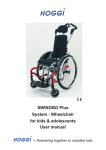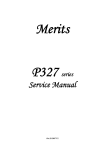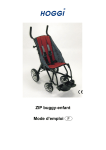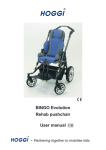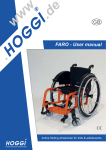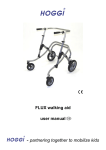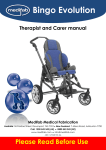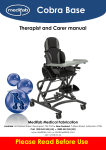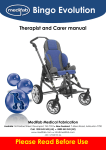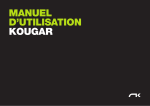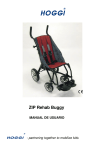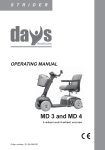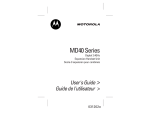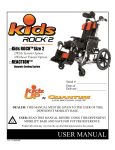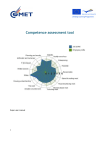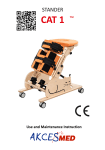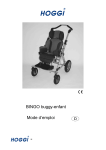Download SUPRA User Manual 2014
Transcript
SUPRA Active-Wheelchair for kids & adolescents - partnering together to mobilise kids User Manual for SUPRA Active-Wheelchair for kids & adolescents content page 1 Common information 1.1 Preface ___________________________________________________________________ 1.2 Application _________________________________________________________________ 1.3 Declaration of conformity______________________________________________________ 1.4 Terms of warranty ___________________________________________________________ 1.5 Servicing and repairs_________________________________________________________ 2 Safety instructions ______________________________________________________________ 3 2.1 Meaning of symbols _________________________________________________________ 3 2.2 Common safety instructions __________________________________________________3-5 3 Delivery and preparing for use __________________________________________________6-10 4 Adjusting and adaptation possibilities ____________________________________________ 10 4.1 Brake ____________________________________________________________________ 10 4.2 Seat width / seat height / active degree / camber __________________________________ 11 4.3 Seat depth ________________________________________________________________ 11 4.4 Seat upholstery /utensil bag _______________________________________________ 12+13 4.5 Backrest height / backrest upholstery ___________________________________________ 13 4.6 Backrest with additional backrest relax position (15° ) ______________________________ 14 4.7 Lower leg length ___________________________________________________________ 14 4.8 One piece, swingaway footrest / separated, swingaway footrest ______________________ 14 4.9 Seat angle ________________________________________________________________ 15 4.10 Height adjustment of the single push handle _____________________________________ 16 4.11 Height adjustment of the push-bar _____________________________________________ 16 4.12 Anti-tip ________________________________________________________________ 16+17 4.13 Detaching wheels with quickrelease_____________________________________ _______ 17 4.14 Pneumatic tyres / PU-tyres ________________________________________________ 17+18 4.15 Hand rims_________________________________________________________________18 5 Accessories ___________________________________________________________________ 19 5.1 Seat cushion ______________________________________________________________ 19 5.2 Spoke guards _____________________________________________________________ 19 5.3 Push-bar _________________________________________________________________ 19 5.4 Single push handle _________________________________________________________ 20 5.5 Anti-tip ___________________________________________________________________ 20 5.6 Lap belt _______________________________________________________________ 20+21 5.7 Ankle hugger ______________________________________________________________ 21 5.8 Calf strap _____________________________________________________________ 21+22 6 Transportation _________________________________________________________________ 6.1 In the trunk (luggage space) of a car ___________________________________________ 6.2 Using SUPRA Active-Wheelchair for kids & adolescent for bus transport ____________________ 6.3 Transfer - getting into or out of the wheelchair ____________________________________ 7 Maintenance __________________________________________________________________ 24 8 Technical Data _________________________________________________________________ 25 1 2 2 2 2 2 22 22 23 23 1 Common information 1.1 Preface Thank you for selecting the SUPRA wheelchair. We have designed this high-quality product to make your life safer and easier, and we’ve included this manual to help you use and care for it. Please read the following instructions to make sure you use this product as recommended. If you have any further questions, or if you have any problems, please contact your healthcare provider. We hope that SUPRA meets your expectations. The design, as described in these Instructions for use, are subject to technical alterations without notice. 1.2 Application The SUPRA wheelchair is designed solely for individual indoor and outdoor use by persons who are unable to walk or who have a walking impediment, and can be operated by the patient or by another person. Assistance may be required due to: • Paralysis (paraplegia / tetraplegia or tetraparesis) • Muscle and nerve disorders • Loss of limbs (dysmelia/lower limb amputation) • Imperfect osteogenesis • Infantile/spastic cerebral palsy • Poliomyelitis • Spina bifida 1.3 Declaration of conformity HOGGI® GmbH as manufacturer with sole responsibility declares that the SUPRA Active-Wheelchair conforms to the requirements of the 93/42/EEC Guidelines. 1.4 Terms of warranty Warranty applies only when the product is used according to the specified conditions and for the intended purposes, following all manufacturer’s recommendations. The manufacturer is not responsible for damages caused by components and spare parts not approved by the manufacturer. 1.5 Service and repairs Service and repairs on the SUPRA Active-Wheelchair should only be carried out by authorized HOGGI dealers. Should any problems arise, please contact the dealer who supplied your SUPRA. Authorized dealers only fit original HOGGI spare parts. For Preparing, repair and service, the following tools are required: Allen wrench size: 3 mm, 4 mm, 5 mm and 6 mm Wrench, sizes: 8 mm, 10 mm, 13 mm, 17 mm, 19 mm, 24mm Your authorized HOGGI dealer: 2 2 2.1 Safety instructions Meaning of symbols Caution! Warning of possible danger of accident and injury. Warning of possible technical damage. Information! About use of product. Information! For service-personnel. Attention! Read manual before use! 2.2 Common safety instructions Read manual completely before use! Familiarize yourself with handling and functions of the wheelchair before use and practice the various functions. You are responsible for the safety of your child. The safety of your child could be affected if you do not follow the instructions of this manual. Nevertheless not all possible circumstances and unpredictable situations can be covered by this manual. Reason, care and circumspection are not features of the product, they are required of persons, who use the wheelchair or attend it. The person, who is using the wheelchair and its accessories should understand all instructions. It must explained to every other person using the wheelchair and its accessories. If instructions are not clear and further explanations become necessary, or if you have further questions please contact your HOGGI dealer. Practice with the new wheelchair on even, straightforward terrain first, together with the child. Together with the child, learn how the wheelchair reacts when the centre of gravity shifts; for example on slopes or inclines or when clearing obstacles such as steps and curbs. This should be done only with assistance from another person. Using an anti-tipper is strongly recommended for inexperienced wheelchair users. Strap in your child at all times, when they are in the wheelchair. HOGGI points out, that any use beside the typical use can be dangerous. The wheelchair is not suitable for jogging, running, skating or similar activities. Swivelling front wheels tend to wobble at higher speed, which can cause a sudden stop and tip over of the wheelchair. Use the wheelchair only at regular walking speed. Under no circumstances leave the handle bar while pushing and never push the wheelchair away. The wheelchair should only be used on solid level ground. Use your wheelchair as intended by the manufacturer. For instance, do not drive into obstacles (including steps, curbs) without braking. Do not „jump” the chair down from higher surfaces. 3 To clear obstacles such as steps and curbs, tilt the wheelchair onto the rear wheels (pull it backwards to go up; to descend, slowly lower it forward). If only one attendant is available when ascending or descending stairs, an incorrectly set anti-tipper (if mounted at all) can lead to severe falls. Adjust the anti-tipper so that it does not come in the way of the steps during transport. Afterwards, swing the anti-tipper back to its operational position. Do not go up or down stairs without the assistance of another person. If devices such as ramps or elevators are available, please use them. Ensure that the anti-tipper (if mounted) is outside the danger-area. If wheelchair friendly access is missing, two attendants must carry the wheelchair over the obstacle. When ascending slopes or ramps and when crossing obstacles on upward slopes, always lean the wheelchair user‘s upper body far forward. When descending slopes, do not drive without braking and reduce your speed. Reduced load on the casters due to centre of gravity shifting can cause the casters to flutter. If you have to park on a slope, face the wheelchair uphill with the brakes engaged and ensure that the seat is in the upright position. There is a risk that the pushchair might tip over backwards if the seat is equipped with the recline feature and it is in the reclined position. Before leaving the wheelchair and before getting into and out of it, always lock the wheel locks. It is only allowed for children with a body weight less than 20 kg to stand on the footplate getting into the wheelchair. For children above 20 kg fold up the footplate before getting into or out of the wheelchair. Depending on footplate settings and wheelchair geometry, the wheelchair may tip over if the user boards the chair using the footplate. First practise boarding the chair with the child and an attendant who can secure the wheelchair, and modify footplate and seat height settings if the chair has a tendency to tip over. In addition, turn the caster fork to the front prior to using the footplate for getting into the wheelchair; this increases the wheelbase and thereby the wheelchair‘s stability against tipping. Please be aware that with certain footrest settings the footrest can collide with the caster wheels. If this occurs select a different seat height or frame length. The effectiveness of the wheel lock and the overall driving quality are dependent on adequate air pressure. With properly inflated rear wheels and even tyre pressure on both sides, your wheelchair is much easier to operate and manoeuvre. Before starting to use your wheelchair, check that the tires are inflated correctly. The required air pressure is printed on the side of the tyre. For rear wheels, it should be at least 6 bar.. All brakes acting on the tires do not serve as a slow down brake but are only designed as a parking brake (wheel lock). The wheel locks must not be used as driving brakes for slowing down the wheelchair, as in extreme cases, the abrupt stopping of the wheelchair can lead to falls. Please keep packaging material away from children. Plastic packaging presents the danger of suffocation. Never leave your child unattended in the wheelchair even when they are strapped in and the brakes engaged. 4 In the dark, the user should wear light clothing or clothing with reflectors in order to improve visibility. Ensure that the reflectors if installed are easily visible. We also recommend installing active illumination. Static stability is at xx° inclination. Attaching heavy bags or other weight to the push handles can adversely affect stability. Extreme settings (e.g. shortest wheelbase and seat in the backmost position) combined with an unfavourable body posture can cause the wheelchair to tip even on level ground. Under no conditions should the anti-tipper assume the function of transport wheels, for example to transport a person in the wheelchair with the rear wheels removed. The antitipper must audibly lock in place, before it is able to bear loads. Firm seating must be verified by the user or by an attendant. The SUPRA wheelchair is only intended to carry one child at a time. The maximum load for the SUPRA wheelchair is 75 kg. Accessories and add-ons reduce the maximum load proportionately. Caution! We recommend that, wherever and whenever possible, users transfer to the seats installed in the motor vehicle and use the corresponding vehicle restraint systems, because this is the only way to ensure optimum protection of the passengers in case of an accident. Your SUPRA wheelchair is not permitted for use as a seat in a motor vehicle. Be careful in case of extreme temperatures. The wheelchair can heat up significantly when in the sun or in the sauna. In extreme cold, there is a risk of hypothermia. Slowing down from high speeds or when descending longer slopes tends to heat up the hands and fingers, especially if using aluminium push rings. When using the wheelchair outdoors, leather gloves should be worn. Gloves provide the wheelchair user with a better grip and protect his or her fingers from dirt and hot metal. Always make sure that the quick-release axles are correctly set on the rear wheel. It must not be possible to remove the rear wheel unless the button on the quick-release axle is pushed. Whenever you change any settings on the wheelchair, make sure that you firmly tighten any screws that have been loosened 5 3 Delivery and preparing for use 1 Your SUPRA wheelchair will normally be supplied with the backrest folded and with front castors and rear wheels removed. For transportation the seat angle has been set. Adjust the seat to the required angle (see section 4.9). The original package contains the following parts: • Chassis and seating unit with folded backrest • Rear wheels and quick-release axles unmounted • Front castors already mounted in the front castor forks. These are for the dealer to attach to the wheelchair • Additional accessories as ordered • Instructions and list of tools required Remove the transport packaging carefully. To prepare the wheelchair for use please proceed as follows: • Grip the head of the quick-release axle as illustrated (2) and press the release knob. 2 • Whilst pressing the release knob, position the quick-release axle into the rear wheel bearing (3). 3 • Tilt the wheelchair onto the front castors and lift the wheelchair by holding the rear of the seat (4). • Insert the rear wheel and the quick-release axle into the axle housing. Hold the spokes (4) close to the wheel hub and press the release knob with your thumb. The rear wheel can then be easily slid into position • Ensure that the quick-release axle is securely fixed in the axle housing. CAUTION! Push each rear wheel to check that each quick-release axle is safely located. 4 • If your SUPRA wheelchair is supplied with a retractable backrest pull the bowden cable as shown (5). • Let the bolt lock in place in the desired position. 5 CAUTION! Check with a sharp push on the backrest that the bolt is securely located. 6 • If your SUPRA wheelchair is supplied with a bolt on backrest it is possible that it is partially disassembled, folded and bolted for transport (6). • In that case it must be adjusted and assembled by the technician. Whenever you change any settings on the wheelchair, make sure that you firmly tighten any screws that have been loosened. 6 • Illustration 7 shows an anti tip (directed to the front). • That is the non-active position. 7 The SUPRA wheelchair can be supplied with one or with two anti tippers. • Illustration 8 shows an anti tip in „active position“. 8 • To adjust the „active position“ push the anti-tip with your foot to the bottom. 9 • Turn the anti-tip to the left as shown in illustration 10 (if the anti-tip is mounted on the left side turn it to the right side). 10 7 • The length of the anti-tipper can be adjusted by using the three positions on its locating tube (11). • The anti-tipper should be positioned so that the small wheel at the end of anti-tipper tube projects beyond the radius of the rear wheels and approximately 2-3 cm above the ground (11). 11 CAUTION! By tipping the wheelchair carefully backwards onto the anti-tippers, check that they are securely located. If your SUPRA wheelchair is equipped with a push bar please proceed as follows: • Open the cam lever (12) on both sides. 12 • Place the push bar down into their locating brackets (13). 13 • Press in the spring button and slide the push bar (14) downwards fully into its bracket, until it clicks into position. 14 • Close the cam lever on both sides (15). 15 8 • When the cam lever is open, its tension can be altered by adjusting the nut (16). CAUTION! The maximum adjustment of the push bar is predetermined. Under no circumstances should they be adjusted beyond these limits. Press on the push bar to ensure that they are securely located. 16 If your SUPRA wheelchair is supplied with seat or back upholstery from HOGGI, please proceed as follows: • Slide the upholstered seat cushion (17) under the backrest and lay the seat cushion on the seat surface as illustrated. 17 • Fasten the flap of the seat cushion to the back edge of the seat surface (18). 18 • Place the seat cushion as shown (19). 19 • Fix the seat cushion on the front edge of the seat (20). 20 9 • Fix the backrest upholstery as shown in illustration 21. 21 4 Adjusting and adaptation possibilities 4.1 Wheel lock (brakes) • To apply the brakes press down on the brake lever with the fingers or with the palm of your hand (22). 22 Caution! All brakes acting on the tires do not serve as a slow down brake but are only designed as a parking brake (wheel lock). The wheel locks must not be used as driving brakes for slowing down the wheelchair, as in extreme cases, the abrupt stopping of the wheelchair can lead to falls. • The brake shoe presses on the tires and grips it tightly. The brake shoe is, therefore, at a 90° angle to its holder (23). • The brake shoe should be positioned 3 - 5 mm above the centre line of the wheel. 23 Caution! The effectiveness of the wheel lock are dependent on adequate air pressure. Before starting to use your wheelchair, check that the tires are inflated correctly. The required air pressure is printed on the side of the tires. For rear wheels, it should be at least 6 bar. • To release the brake pull the brake lever upwards (24). 24 • When the brakes are released the brake shoe should be 12-15 mm from the wheel (25 A). • This distance can be adjusted by the adjustment screw (25 B) or by moving the brake at the mounting bracket (25 C). • The brakes should only be adjusted by a technician. B C A 25 10 4.2 Seat width / seat height / active degree/ camber The SUPRA seat unit is available in nine seat widths from 24 - 40 cm. The arrow in illustration 26 shows the seat width. The SUPRA wheelchair will be built in accordance with the customer’s order. It is possible for the technician to modify the wheelchair with a different seat width. 26 The seat height (27) is dependent on the chosen rear wheels and front castors, as well as on the height of the rear axle and the position of the front castors in the front castor forks. The SUPRA wheelchair will be built in accordance with the customer’s order. It is possible for the technician to alter the wheelbase. 27 The active degree (28) describes the relation of the backrest position to the rear wheels. The more the backrest is positioned to the rear of the axle, the more active the wheelchair can be driven. That means contrary a safer driving position if the adjustment is set above or in front of the rear axle. The active degree can be adjusted in ten steps (from -3° to +6°). At this the distance of the rear axle to the backrest gets adjusted. 28 The SUPRA wheelchair can be supplied with rear wheels inclined (camber) 6° (29 left) or 9° (29 right) from the vertical. The SUPRA wheelchair will be built in accordance with the customer’s order. It is possible for the dealer to modify the camber of the rear wheels. 29 4.3 Seat depth To adjust the seat depth first remove the seat cushion. Loosen the four screws under the seat (on both sides) and adjust the seat depth by sliding the seat to the required position. Whenever you change any settings on the wheelchair, make sure that you firmly tighten any screws that have been loosened. 11 30 B A 4.4 Nylon seat cover / Utility bag The SUPRA wheelchair is supplied with a stretchable nylon seat cover and an utility bag under the front edge of the seat (e.g. for a wallet) (32). • To stretch the nylon seat cover remove the seat cushion and loosen the four fasteners (31). 31 We suggest to remove the utility bag before stretching. • Loosen the Velcro fasteners and remove the bag (32). 32 • Loosen the hook bands under the seat, stretch the nylon seat cover and attach the hook bands (33). 33 • Tighten the four fasteners as shown (34). 34 • Fix the Velcro fasteners and place the bag (35). 35 12 • Fix the seat cushion (36). 36 4.5 Backrest height / backrest upholstery Backrest frames are available in three different backrest heights. The adjustment of the backrest height is realisable by using telescopic tubes (available in two different sizes) or through the height adjustment of the single push handle (see also 4.10). • Drop the backrest cushion initiating from the back side (37). • Position your desired backrest height by inserting the telescopic tubes or rather by using the height adjustment of the single push handle (see also 4.10.). 37 • If your SUPRA wheelchair is supplied with a preset backrest height there are further Velcro fastener included in the scope of delivery for positioning a higher backrest height. • Post the self-adhesive fleece strip (included in the scope of delivery) in the now released space as shown in the illustrations (38 + 39). The Velcro fasteners must be positioned compatibly to the newbackrest height. 38 • Adjust the tension of the Velcro fasteners as desired. 39 • Fix the backrest cushion, starting from the front (40). Look out that the open area in the backrest cushion is positioned above the locking device (40 A) and consequently prevents clamping of the backrest cushion in the backrest relax position (optional). A 40 13 4.6 Backrest with additional relax position (15°) • Pull the bowdencable and fold the backrest into the relax position of 15°. Illustration 41 shows the wheelchair in the relax position (15°). 41 4.7 Lower leg length • Loose and remove both attachment screws (42). 42 • By adjusting the footrest it is possible to position the lower leg length (43). 43 Whenever you change any settings on the wheelchair, make sure that you firmly tighten any screws that have been loosened. 4.8 Foot rest / Foot rest with swingaway single foot boards SUPRA can be supplied with a foot rest with a persistent swingaway foot board (44) or with swingaway single foot boards (45). Illustration 44 shows a foot rest with a persistent swingaway foot board. 44 Illustration 45 shows a foot rest with swingaway single foot boards. 45 14 4.9 Seat angle The seat angle depends on the size of the choosen rear- and front wheels selected (46) as well as the height position of the rear axle and the position of the front wheels in the caster fork (47). A variety of seat angles can be used given wheel combination and camber options from the orderform. The SUPRA wheelchair will be built in accordance with the customer’s order. It is possible for the dealer to modify the seat angle. 46 47 Provided that the seat height (front) should be retained, there must be a change of the angle by adjusting the position ot the axle (vertical) and readjusting of the caster fork (right and left side) (49). 48 B • Loosen the nut on the bottom side of the clamp (49 A) • Use the hexagon socket screw wrench to adjust (49 B). 49 49 A • Remove the cover on the caster fork to position the bubble level and check if the caster fork is at a right angle to the floor (50). • Readjust if necessary (see illustration 49). Whenever you change any settings on the wheelchair, make sure that you firmly tighten any screws that have been loosened. 50 15 90° 4.10 Height adjustment of the single push handle The push handles can be adjusted to a comfortable height for the care giver. • Loose the fasteners as shown (51). 51 • Pull the single push handle to the desired position (52). • Tighten the fasteners. 52 Whenever you change any settings on the wheelchair, make sure that you firmly tighten any screws that have been loosened. 4.11 Push bar • By pressing the knobs on both ratchet joints, the push bar can be turned to the required position.(53). 53 4.12 Anti-tip • The angle of the anti-tippers can be adjusted by loosening the screw (54). 54 • To achieve more free space for the feet it is possible to turn the anti tip outwards (55). 55 16 The length of the anti-tipper tubes can be adjusted in the anti-tipper bracket in three positions 2.5 cm apart (56). 56 There are also two alternative positions in the anti-tipper tube, 1.5 cm apart (57). 57 4.13 Detaching the rear wheels with quick-release axles The rear wheels are removed by means of a quick-release mechanism. This reduces the volume of the wheelchair for transportation: • Tilt the wheelchair onto the front castors and lift it by holding the rear edge of the seat. • Grip the spokes close to the wheel hub and, with the thumb, press the release knob of the quick- release axle. • Pull the rear wheel with the quick-release axle out of the axle housing. 58 • To avoid a risk of snagging, it may be preferable to withdraw the quick-release axles from the rear wheels. • To re-assemble the rear wheels refer to section 3 “Delivery and preparing for use”. CAUTION! Push sharply on each rear wheel to ensure that the quickrelease axles are securely located. 59 4.14 Pneumatic tires / PU-tires The rear wheels can be supplied with pneumatic tires (61, left). The car type valves enable the tyres to be checked or inflated at any petrol station or by means of a suitable pump, supplying a minimum 6 bar pressure. Check the maximum tire pressure, which is indicated on the tire. 60 17 The drive wheels can also be supplied with solid PU-tyres (61, right). 61 4.15 Hand rims Hand rims can be supplied in aluminium (62) or stainless steel (63) according to preference. 62 • Stainless steel hand rim 63 Hand rims can be supplied with a standard diameter (64, left) or with a larger diameter (64, right). These are called respectively hand rims “standard” or hand rims “high”. The SUPRA wheelchair will be built in accordance with the customer’s order. It is possible for the retailer to fit alternative push rims. 64 All hand rims can be mounted close to the rear wheel or a little further apart. This can be changed in the future. 65 18 5 Accessories All accessories not installed by the manufacturer must be installed by trained technicians. The following notes on installation are for your information but should be performed by trained technicians. Straps on accessories are usually extra long to accommodate every option. Shorten excess strap ends on accessories so that they can not be trapped. To prevent strap ends from fraying the cut ends can be melted together with a flame. (eg. cigarette lighter) 5.1 Seat cushion The HOGGI seat cushion is 3 cm thick and is foam filled (66). The cushion cover is washable and can be unzipped to remove the foam pad. In order to adjust the seat depth, the seat cushion must first be removed. 66 5.2 Spoke guards The spoke guards prevent the child’s fingers from being trapped in the spokes (67). The transparent spoke guards can be painted by the child or have decorative stickers applied (67). 67 5.3 Push bar The push bar (68) is designed to push the SUPRA wheelchair. The push bar is equipped with a continuous handle. As described in section 4.11, the height of the push bar can be adjusted by the ratchet joints. 68 For transportation the push bar can be removed by loosening the cam lever or by pushing it inwards as far as it will go. See also under “Delivery and preparing for use” and illustration (12 - 15). Whenever you change any settings on the wheelchair, make sure that you firmly tighten any screws that have been loosened. 19 69 3 cm 5.4 Single push handle The single push handle serves as a pushing help, for the child that is otherwise able to drive the wheelchair unaided. The push handle can be supplied in a short or long version (70). By loosing the fastener the single push handle is easily heightadjustable (see also illustration 51 and 52). 70 5.5 Anti-tip The wheelchair can be supplied with one or two anti tipper units. The anti-tipper increases the stability of the wheelchair. The function and attachment of the anti-tippers is described in the section “Delivery and preparing for use“. 71 72 Caution! If only one attendant is available when ascending or descending stairs, an incorrectly set anti-tipper (if mounted at all) can lead to severe falls. Adjust the anti-tipper so that it does not come in the way of the steps during transport. Afterwards, swing the antitipper back to its operational position. 73 5.6 Lap belt At the end of the lap belt you can find pre assembled tri-glide. Loose them. • Thread the ends of the lap belt so that the belt material passes through the tri-glide only once. (74). The length of the free beltend defines the length of the lap belt. 74 20 • Guide the free beltend through the backrest bracket as shown (75). 75 • Guide the free beltend once more through the tri-glide (76). 76 • Open the lap belt by pressing the red button (77). When the lap belt is fastened, fine adjustment can be made by pulling one free end of the belt. 77 5.7 Ankle hugger - in association with footboard only By using the ankle straps feet and ankles can be comfortably positioned. The ankle straps are passed through the rings on the foot rest. This holds the heels against the raised heel plate at the rear of the footrest. The ankle straps can be adjusted and then fastened with Velcro. The fastening should always be on the outside. 78 5.8 Calf strap The calf strap starts at the lower leg and prevents, the feet from sliding off the foot board. • Change the desired height position and fix the provided, self adhesive fleece strap onto the frame (79). Repeat on the other side. 79 21 • Fix the provided Velcro straps as illustrated (80). 80 • For a tight calf strap adjustment fix it as shown (81). • For a long calf strap adjustment fix it not too close onto the frame. 81 • To fix (a possible overlaying calf strap) use the short, provided piece of Velcro fastener. (82). . 82 83 6 Transportation 6.1 In the trunk (luggage space) of a car The SUPRA wheelchair can, according to model, size and specification, be transported as one unit, with folded down backrest and folded up foot rests (83). For convenience of handling it may be preferable to partially dismantle the wheelchair into a few main components. To achieve the most compact folding package fold the backrest and foot rest but remove the rear wheels, the anti-tipper assemblies and the push bar/ push handles (84). 84 22 6.2 Using SUPRA Active-wheelchair for kids for bus transport Caution! We recommend that, wherever and whenever possible, users transfer to the seats installed in the motor vehicle and use the corresponding vehicle restraint systems, because this is the only way to ensure optimum protection of the passengers in case of an accident. Your SUPRA wheelchair is not teted for use as a seat in a motor vehicle. 85 6.3 Transfer - getting into or out of the wheelchair In general there are two ways of getting into and out of the wheelchair. For children the foot rest can be used as a step, when getting in or out of the wheelchair (86). Caution! • Always lock the wheel locks before getting into or out of the wheelchair. • It is only allowed for children with a body weight less than 20 kg to stand on the footplate getting into the wheelchair. For children above 20 kg fold up the footplate before getting into or out of the wheelchair. • Depending on footplate settings and wheelchair geometry, the wheelchair may tip over if the user boards the chair using the footplate. • First practise boarding the chair with the child and an attendant who can secure the wheelchair, and modify footplate and seat height settings if the chair has a tendency to tip over. • In addition, turn the caster fork to the front prior to using the footplate for getting into the wheelchair; this increases the wheelbase and thereby the wheelchair‘s stability against tipping.. 86 87 For adolescents it can be advantageous, according to age, weight and ability, to make a transfer over the side of the wheelchair. Firstly position the wheelchair at an angle of 45° to the seat or wheelchair (89), from which a transfer is to be made. Apply the parking brake (87). During the transfer the seat surface, the backrest surface, the push rims or briefly the side of the seat can be used for support. The transfer should be practiced with a helper, until it can be accomplished safely. The transfer should be carried out in one movement. 88 Afterwards, fold down the foot rest and position the feet on it If necessary correct the seat position. Finally the parking brake (87) can be released and the wheelchair is ready for use. Carry out the sequence in reverse when getting out of the wheelchair. 89 23 7 Maintenance Your SUPRA wheelchair is CE approved. The manufacturer herewith guarantees that this medical product as a whole conforms to the requirements of 93/42/EEC Guideline. The proper function of the wheelchair, especially of the wheel locks, should be checked before every use. Safety nuts should be used only once. If they have been loosened several times, they must be replaced. The items listed in the following table must be checked by the user at the indicated intervals. Failure to carry out these simple checks may lead to problems arising that could invalidate the warranty.n. Check daily before use Function test of the brake/wheel lock X Function test of the anti tip X Function of rear wheels quick-release system X weekly Check stability of footplate X Air pressure (see indication on tyre) X Push rims for damage X Screw connections monthly X Visual inspection for worn parts (e.g. tyres, bearings) X Dirt on bearings X Spoke tension of the rear wheelss X Should any defects become obvious, please contact your authorized HOGGI dealer to eliminate them. We also recommend that you have your SUPRA serviced by your technician every twelve months. Instructions for cleaning and maintenance - Clean all frame components and plastic parts using mild detergents only. (e.g. Sagrotan) - Padding parts can be washed at 40 °C. If washed in a washing machine, put them in a linen bag or a pillow case. - In most cases, wiping with a damp cloth is sufficient.. - Do not use your SWINGBO wheelchair in salt water. - Keep sand or other particles from damaging the wheel bearings. - If your wheelchair gets wet, towel-dry it as soon as possible. - Hair and dirt particles generally accumulate between the caster wheel and fork. This can restrict the caster wheels from rotating smoothly. Remove the caster and thoroughly clean the fork and caster using a mild detergent. - The rear wheels feature a quick-release system. To keep this system operational, ensure that no dirt adheres to the quick-release axle or axle housing. The quick-release axle should also be lightly lubricated regularly with resin-free sewing machine oil. - Screw connections should be checked frequently, in particular when beginning to use the wheelchair and after any adjustment. If a screw connection becomes loose repeatedly, consult your dealer. 24 8 Technical data Dimensions (cm) and weights (kg) Seat width Standard Ttoal Seat depth adjustable Back rest height adjustable Short Middle Long Seat height Front Seat anglel Back rest angle Lower leg length Standard Rear wheels Front wheels Capacity Weight Size 1 Size 2 Size 3 24 - 30 24 - 40 17 - 34 28 - 34 24 - 40 22 - 39 32 - 40 24 - 40 28 - 45 20 - 25 25 - 35 30 - 40 20 - 25 25 - 35 30 - 40 20 - 25 25 - 35 30 - 40 34 - 43 0° - 15° 75° - 105° 37 - 46 0° - 15° 75° - 105° 41 - 49 0° - 15° 75° - 105° 27 - 41 20“, 22“, 24“ 4“, 5“, 5,5“ 75 kg 8,4 kg 30 - 44 20“, 22“, 24“ 4“, 5“, 5,5“ 75 kg 8,9 kg 34 - 48 20“, 22“, 24“ 4“, 5“, 5,5“ 75 kg 9,4 kg 25 Hoggi GmbH Taunusstrasse 17 56235 Ransbach-Baumbach GERMANY Fon: (+49) 26 23 / 92 499-0 · Fax: (+49) 26 23 / 92 499-99 e-mail: [email protected] · Internet: http://www.hoggi.de © HOGGI GmbH 1910-0017-GB_04-2010 Hersteller/Manufacturer:




























